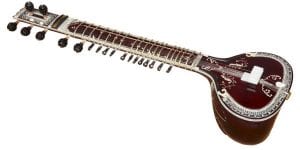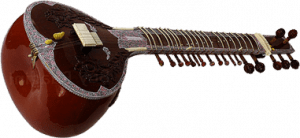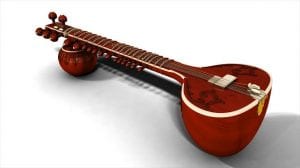In the western world, the sitar is perhaps the most well known musical instrument of India. Its sound evokes thoughts and feelings of the sub-continent. It is believed to have evolved into its present form in the 1700s, during the collapse of the Moghul Empire, as a marriage between the Persian Setar and the South-Indian Vina, while using the characteristically resonant bridge of the Tampura.

There is a common story attributing the invention of the sitar to Amir Khusru. Amir Khusru was a great personality and is an icon for the early development of Hindustani Sangeet (North Indian classical music). He lived around 1300 AD. As common as this story is, it has no basis in historical fact. The sitar was clearly nonexistent until the time of the collapse of the Moghul Empire.
Another theory has the sitar evolving from the ancient veenas such as the Rudra vina. However the Rudra vina is a stick zither while the sitar is a lute, and there are differences in materials used. It is not very likely that the sitar owes its origins to this instrument.
Some suggest that the sitar is derived from the Saraswati vina. This is at least a possibility. Still, there are questions raised. Where did the Saraswati vina come from? Why does this class only begin to show up in India about 800 years ago? There is a possibility that the lute class of chordophones is not indigenous to India but was imported from outside.

It is clear that the sItar as we think of it today developed in the Indo-Pakistan subcontinent at the end of the Moghul era. It is also clear that it evolved from the Persian lutes that had been played in the Moghul courts for hundreds of years. The “Sangeet Sudarshana” states that the sitar was invented in the 18th century by a fakir named Amir Khusru. This, of course, was a different Amir Khusru from the one who lived in 1300. This latter Amir Khusru was the 15th descendant of Naubat Khan, the son-in-law of Tansen. It is said that he developed this instrument from the Persian Sehtar.
Amir Khusru’s grandson Masit Khan was one of the most influential musicians in the development of the Sitar. He composed numerous slow gats in the dhrupad style of the day. This style is referred to as Masitkhani Gat. The Masitkhani gats were further popularized by his son, Bahadur Khan. Masit Khan was a resident of Delhi; therefore Masitkhani Gats are sometimes referred to as Dilli Ka Baaj.

Raza Khan was also an important person in the development of sitar music. Raza Khan was also a descendant of Tansen and lived in Lucknow around 1800-1850. Raza Khan was also known as Ghulam Raza. He developed the fast gat known as Razakani gat.
Amrit Sen and Rahim Sen are credited with modifying the tuning and stringing of the Sitar and introducing numerous new techniques to the instrument.
Hear the Sitar on ‘Ong Namo Guru Dev Namo’, ‘Dharana’, and ‘Bar-Bar-A’ from ‘Svadharma‘, and on ‘Ong Namo Guru Dev Namo’ from ‘‘Sa Ta Na Ma’
Also published on Medium.
